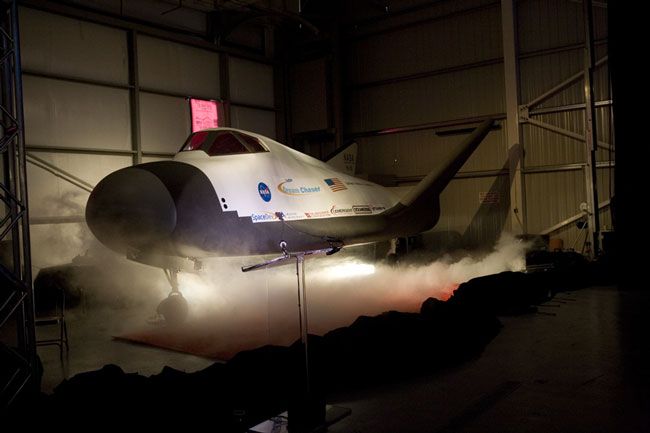
ENGLEWOOD, Colorado – A space plane designed for hauling passengers and cargo into Earth orbit was shown here June 21—the SpaceDev Dream Chaser—one of a handful of finalists in NASA’s Commercial Orbital Transportation Services Demonstration (COTS) effort.
The vehicle is a candidate for NASA’s four year $500 million COTS initiative. The Dream Chaser would be capable of carrying one to six people and/or cargo to the International Space Station, with the winged craft able to return to almost any runway in the world.
Dream Chaser draws from extensive work and evaluation of NASA’s HL-20 lifting body—an enhanced horizontal lander advanced by the space agency’s Langley Research Center in Hampton, Virginia. The HL-20 itself evolved from work in the 1960s and 1970s on several lifting body shapes.
>
"The HL-20…it’s the best vehicle out there…but also a vehicle with heritage," said Mark Sirangelo, Chief Executive Officer of SpaceDev, Inc., based in Poway, California. NASA shelved the concept with perhaps as much as a billion dollars being spent, along with years of experience and tests showing the viability of the craft, he said.
"We’re now going to turn it into something that is going to pay back to the American people and NASA," Sirangelo explained to a gathered audience here at a Centennial Airport hangar. "The point here is that we’re not starting the program from scratch," years and years of development work has already been completed, he said.
Sirangelo said that Dream Chaser can provide an array of products and services. For COTS, the craft can deliver cargo and crew to the International Space Station. Furthermore, the vessel can be configured to launch, repair, and upgrade satellites, as well as operate as a passenger-carrying craft to handle suborbital, as well as orbital public space travel traffic.
The vehicle is a candidate for NASA’s four year $500 million COTS initiative. The Dream Chaser would be capable of carrying one to six people and/or cargo to the International Space Station, with the winged craft able to return to almost any runway in the world.
Dream Chaser draws from extensive work and evaluation of NASA’s HL-20 lifting body—an enhanced horizontal lander advanced by the space agency’s Langley Research Center in Hampton, Virginia. The HL-20 itself evolved from work in the 1960s and 1970s on several lifting body shapes.
>
"The HL-20…it’s the best vehicle out there…but also a vehicle with heritage," said Mark Sirangelo, Chief Executive Officer of SpaceDev, Inc., based in Poway, California. NASA shelved the concept with perhaps as much as a billion dollars being spent, along with years of experience and tests showing the viability of the craft, he said.
"We’re now going to turn it into something that is going to pay back to the American people and NASA," Sirangelo explained to a gathered audience here at a Centennial Airport hangar. "The point here is that we’re not starting the program from scratch," years and years of development work has already been completed, he said.
Sirangelo said that Dream Chaser can provide an array of products and services. For COTS, the craft can deliver cargo and crew to the International Space Station. Furthermore, the vessel can be configured to launch, repair, and upgrade satellites, as well as operate as a passenger-carrying craft to handle suborbital, as well as orbital public space travel traffic.

